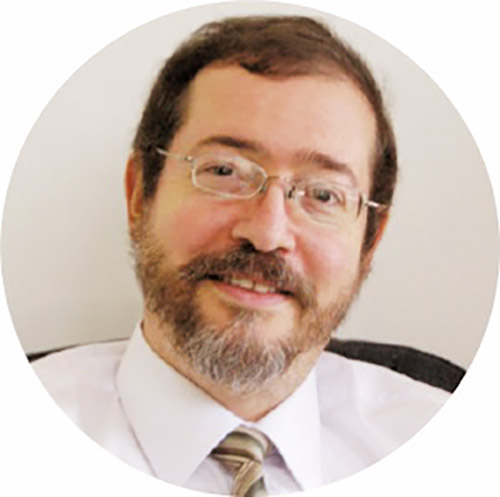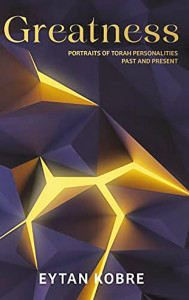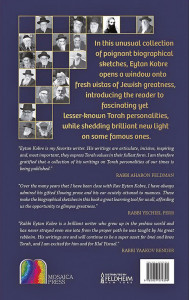
Reviewing: “Greatness: Portraits of Torah Personalities Past and Present” by Eytan Kobre. Mosaica Press. 2022. English. Hardcover. 254 pages. ISBN-13:
978-1957579399.
This book contains a collection of essays that Eytan Kobre wrote in Mishpacha Magazine outlining the lives and achievements of various Gedolim who lived in America. Each chapter discusses a different rabbi and in many of the chapters, Kobre interviews students and family members of the rabbi, and in some cases even the rabbis themselves. One interesting aspect of this book is that it does not just discuss the Gedolim that many of us already know about and have read biographies about them, but rather also devotes chapters to rabbis whose names people may have heard in the beit midrash, but they are otherwise unfamiliar with them. Likewise, this book is not confined to just discussing rabbis of generations past, but even deals with contemporary rabbis who still walk among us (although, unfortunately, some of those rabbis have passed away since Kobre originally wrote the chapters on them).
In presenting the stories of these various Gedolim, this book does an excellent job of striking a balance between presenting a fawning hagiographic account of the various rabbis it discusses and giving the reader a more realistic down-to-earth sketch of the same rabbis.

The chapter on Rabbi Moshe Feinstein (1895—1986) was presented as the minutes of a meeting in which his various students reminisced about their beloved rosh yeshiva. Rather than focusing on Rabbi Feinstein’s role as Halachic decider for Orthodox Jews across the USA and abroad (which has been written about at length elsewhere), Kobre chose to focus on Rabbi Feinstein’s role as Rosh Yeshiva and mentor to many students in the two yeshivas at whose helm he stood.
No Gedolim biography can be complete without a chapter on Rabbi Yisroel Meir Kagan (1838-1933)—the Chofetz Chaim and his son-law Rabbi Mendel Zaks (1898-1974). For this chapter, Kobre interviewed the Chofetz Chaim’s grandson Rabbi Yisroel Meir Zaks at his home in Flatbush in order to hear more about these two great paragons of righteousness and scholarship. In doing so, Kobre provides us with new miracles stories (like the time that the Chofetz Chaim somehow knew about a local Jew’s secret desecration of Shabbos), but also puts these stories in perspective by citing a quip from Rabbi Avrohom Yehoshua Soloveitchik who denied the possibility that the Chofetz Chaim had a special ramp in his house to practice the rituals in the Holy Temple in Jerusalem. A later chapter is devoted to Rabbi Mendel Zak’s son Rabbi Hillel Zaks (1931—2015).
The author interviewed Rabbi Yechiel Perr about Rabbi Yosef Yoizel Horowitz (1847-1919), known as the Alter of Novardok, and about Rabbi Aharon Kotler (1892-1962). Indeed, an entire chapter is dedicated to Rabbi Aharon Kotler, and a subsequent chapter is dedicated to his daughter-in-law, Rebbetzin Rischel Kotler (1923—2015). There is also a chapter devoted to Rabbi Moshe Heinemann chronicles some of Rabbi Heinemann’s experiences as a student of Rabbi Aharon Kotle,r and he discusses the guiding principles behind Star-K.
Some lesser-known, but equally important rabbis (if not more so) were treated to chapters in this book as well. For example, there is a chapter devoted to Rabbi Yosef Eliyahu Henkin (1881-1973), one of the greatest rabbis in America in the first half of the 20th century. This chapter particularly focuses on Rabbi Doniel Osher Kleinman’s efforts (at the behest of Rabbi Shmuel Kamenetsky) to republish Rabbi Henkin’s Halachic rulings and present them to the next generation, and Rabbi Kleinman’s budding friendship with Rabbi Henkin’s descendant, Rabbi Eitam Henkin (1984-2015), who was tragically murdered by terrorists. (The junior Rabbi Henkin was known to his fellow researcher and colleagues online on the Otzar HaChochmah Forums as Toch Kdei Dibbur).

Likewise, another chapter tells the tragic story of Rabbi Tzvi Hirsch Grodzinski (1857-1947), a world-class talmid chacham who served the Orthodox community in Omaha, Nebraska until he was unceremoniously deposed in favor of younger blood. The bulk of this chapter is actually dedicated to the efforts of Rabbi Myron Wakschlag and Shalom Jacob to publish Rabbi Grodzinski’s remaining unpublished works.
In another chapter, Kobre treats the reader to an interview he conducted with the now-deceased Rabbi Shlomo Carlebach (1925-2022), a Holocaust survivor and scion of the Carlebach rabbinic dynasty from Germany (not to be confused with the singer Rabbi Shlomo Carlebach, who actually does make an appearance in another chapter). After the War, Rabbi Carlebach came to America, where became a student of Rabbi Yitzchak Hutner—eventually serving under him as Mashgiach of Mesivta Chaim Berlin.
Rabbi Chaim Epstein (1936-2015) is a name that those who learn in the beit midrash may have heard of (because of his famous work on the Rashba to Bava Basra), but aren’t that familiar with. He served as the Rosh Yeshiva of Mesivta of Eastern Parkway (also known as Yeshiva Zichron Melech), was one of the most prominent students of Rabbi Aharon Kotler and was very much sought-after for his advice. As you may have guessed, Kobre devotes an entire chapter to telling us more about Rabbi Epstein.
There is also a chapter about Rabbi Levi Yitzchok Horowitz (1921-2009), known as the Bostoner Rebbe, and how he transformed the Jewish community in Boston and touched the lives of many people, including academic-trained professionals like Dr. Meir Wikler and Rabbi Dr. Dovid Gottlieb.
Each of the oldest yeshivas in America are represented with chapters on their respective roshei yeshiva: For Yeshivas Rabbeinu Yitzchak Elchanan (Yeshiva University), there’s a chapter on Rabbi Dovid Lifshitz (1906-1993) and Rabbi Moshe Meiselman. For Mesivta Torah V’Daas, there’s a chapter on Rabbi Yaakov Kamenetsky (1891-1986). And for Ner Israel Rabbinical College, there’s a chapter on Rabbi Dovid Kronglas (1910-1973) and another one on Rabbi Yakkov Yitzchok Ruderman (1900-1987).
Kobre’s interview with Dr. William Helmreich (1945-2020) concludes the book as an appendix. Dr. Helmreich was a frum sociologist, who famously interviewed various yeshiva heads and students to provide a unique study on the yeshiva world.
All in all, Kobre’s book provides a compelling collection of essays about lesser-known and well-known great rabbis who lived in America, striking a balance between presenting hagiographic accounts and realistic sketches of these rabbis. Some of the stories the author relates presents us with the human side of these great Torah luminaries, with the implicit lesson that we too can become like them. Yet on the other hand, the same book spells out what exactly made these rabbis special and unique. Kobre’s interviews with family members and students of the rabbis add a personal touch to the stories.
This book will make you laugh, it will make you cry, but above all it will inspire. Overall, the book provides an insightful and informative read for anyone interested in the history and lives of these influential rabbis in America (and it has a really cool cover, thanks to Mosaica Press’ graphics talented team).
Rabbi Reuven Chaim Klein is a scholar, author, and lecturer living in Beitar Illit, Israel. He has written many scholarly works, including the book Lashon HaKodesh: History, Holiness, & Hebrew (Mosaica Press). To hire Rabbi Klein to collaborate on your project, just send him an email to rabbircklein@gmail.com









